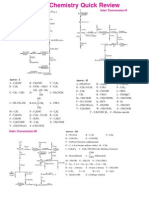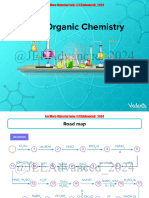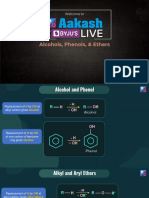Benzene Rxns
Benzene Rxns
Uploaded by
api-465421809Copyright:
Available Formats
Benzene Rxns
Benzene Rxns
Uploaded by
api-465421809Original Title
Copyright
Available Formats
Share this document
Did you find this document useful?
Is this content inappropriate?
Copyright:
Available Formats
Benzene Rxns
Benzene Rxns
Uploaded by
api-465421809Copyright:
Available Formats
Chemistry Specialist: Alicia Hart
BENZENE RXNS UC Davis - SASC
Br
Br2
FeBr3
Cl Ex's: Sn, HCl or H2, raney Ni or Fe, HCl or Zn(Hg), HCl,
Cl2
AlCl3
O
NO2 NH2 O O or O
HNO3 red. agent HN R
R O R R Cl
H2SO4
pyridine
mCPBA
NaOH, H2O,
(aka RCO3H)
or
1. H3O+,
2. NaOH, H2O
SO3H
SO3 H+, H2O,
H2SO4
or
H2SO4,
CH2R
RCH2X Clemmensen
Issues?..polyalkylation and rearrangement Reduction
lewis acid catalyst
O R R
O or O O
1. R Cl Zn(Hg), HCl
R O R , AlCl 3
2. H3O+
Jones
Important things to note about benzene reactions: (p.750 and 22-2 in 6 ed.)
SO3, H2SO4 is used to block the para position of a ring w/ an EDG on it (only a small percentage of the product adds SO3H
ortho) forcing the next group to add exclusively ortho; remove the blocking group using acid and heat.
Activators (EDG's through resonance) have a lone pair on the atom directly attached to benzene (exception: alkyl groups do
not have a lone pair but are EDGs via induction)
Deactivators (EWG's through resonance) do NOT have a lone pair on the atom directly attached to benzene (exception:
halogens have a lone pair but withdraw via induction)
no lone pair but alkyl lone pair but halogens
EX's grps are the exception Cl are the exception O OH
OCH3
lone pair on the O no lone pair
on the C
Activator Activator Deactivator Deactivator
(EDG) (EDG) (EWG) (EWG)
Watch out for benzene rings with OH and NH2 grps on them; they are highly activated and need to be toned down prior to
adding another grp on the ring. If you do not convert them into less activating groups, you will get polysubstitution at both
ortho and para positions. To do this, use either an anhydride or acyl chloride: EX O
OH O
Cl O
Directing Effects - mD opA poX is a helpful mnemonic to remember that
pyridine
Deactivators direct meta, Activators direct ortho and para, and halogens (X)
direct ortho and para even though they are weakly deactivating.
You might also like
- Zinc FinalDocument12 pagesZinc Finalamanuel tafeseNo ratings yet
- Chapter 10-Structure and Synthesis of AlcoholsDocument22 pagesChapter 10-Structure and Synthesis of Alcohols張湧浩No ratings yet
- CH 19Document68 pagesCH 19Britany DyerNo ratings yet
- 金属有机化学课件 PDFDocument408 pages金属有机化学课件 PDFmingNo ratings yet
- Ca SynthDocument1 pageCa Synthapi-465421809No ratings yet
- Ca SynthDocument1 pageCa Synthapi-465421809No ratings yet
- Phenol Rxns IDocument1 pagePhenol Rxns Iapi-465421809No ratings yet
- Ester RxnsDocument1 pageEster Rxnsapi-465421809No ratings yet
- Hydrocarbon: Ashwani Tyagi Sir (Code: ATJEE)Document22 pagesHydrocarbon: Ashwani Tyagi Sir (Code: ATJEE)Prince DigvijayNo ratings yet
- Haloalkanes and Haloarenes1Document15 pagesHaloalkanes and Haloarenes1Poorni RenuNo ratings yet
- Carbonyl Compounds and Carboxylic Acid - Med Easy - Yakeen 2.0 2024 (Legend)Document12 pagesCarbonyl Compounds and Carboxylic Acid - Med Easy - Yakeen 2.0 2024 (Legend)agrawaltwinkle2005No ratings yet
- 6carboxylic AcidsDocument1 page6carboxylic AcidssharmimiameerasanadyNo ratings yet
- Acyl Halide RxnsDocument1 pageAcyl Halide Rxnsapi-465421809No ratings yet
- Amide RxnsDocument1 pageAmide Rxnsapi-465421809No ratings yet
- Nitrile RxnsDocument1 pageNitrile Rxnsapi-465421809No ratings yet
- Ca Rxns IDocument1 pageCa Rxns Iapi-465421809No ratings yet
- Anhydride RxnsDocument1 pageAnhydride Rxnsapi-465421809No ratings yet
- Ca RXN CheckDocument1 pageCa RXN Checkapi-4654218090% (1)
- Phenol SynthDocument1 pagePhenol Synthapi-465421809No ratings yet
- Amine SynthDocument1 pageAmine Synthapi-465421809No ratings yet
- Heck - 3 20 17Document11 pagesHeck - 3 20 17Preeti YadavNo ratings yet
- Haloalkanes & Haloarenes HandbookDocument3 pagesHaloalkanes & Haloarenes HandbookSuhani SubratNo ratings yet
- Roadmap Problem - 3Document1 pageRoadmap Problem - 3abhyudaipathwayNo ratings yet
- Chapter36 - BiomoleculesDocument19 pagesChapter36 - BiomoleculesAkash GoelNo ratings yet
- Grignard Reagent Q.B.Document12 pagesGrignard Reagent Q.B.Aariya KumariNo ratings yet
- Carbonyl Compounds 2 (Named Reactions) - 1Document9 pagesCarbonyl Compounds 2 (Named Reactions) - 1CBIT CIVIL A1No ratings yet
- Road Maps Organic Chemistry Set 1Document82 pagesRoad Maps Organic Chemistry Set 1anshika.sawdekarNo ratings yet
- Chemistry 108B Exam #2 Cheat Sheet 2Document1 pageChemistry 108B Exam #2 Cheat Sheet 2雪郎かざきNo ratings yet
- HYDROCARBONDocument31 pagesHYDROCARBONRaghav VohraNo ratings yet
- All Organic ReagentDocument13 pagesAll Organic Reagentsanjaykumarsaha507100% (1)
- Haloalkanes and Haloarenes Class Notes Manzil JEE 2025Document76 pagesHaloalkanes and Haloarenes Class Notes Manzil JEE 2025Vedant Vohra100% (2)
- 3 Chemical KineticsDocument219 pages3 Chemical KineticsArkaNo ratings yet
- Carbonyl Compounds 1654147338445Document33 pagesCarbonyl Compounds 1654147338445Harsh VardhanNo ratings yet
- Notes - p Block ElementsDocument25 pagesNotes - p Block Elementsshashwat.choudhary2274No ratings yet
- Hydrozirconation - Final 0Document11 pagesHydrozirconation - Final 0David Tritono Di BallastrossNo ratings yet
- CHAPTER25 HeterocyclesDocument44 pagesCHAPTER25 HeterocyclesRiyanto WidodoNo ratings yet
- AIEEE Chemistry Quick ReviewDocument1 pageAIEEE Chemistry Quick ReviewYashwanth KalyanNo ratings yet
- Reactions of Aromatic CompoundsDocument43 pagesReactions of Aromatic Compoundsnathasya100% (1)
- Day-2 Chemical BondingDocument4 pagesDay-2 Chemical BondingpriyanshuNo ratings yet
- Conjugate AdditionDocument15 pagesConjugate AdditionNazifa. E. AzmanNo ratings yet
- Carbonyl Compounds NotesDocument10 pagesCarbonyl Compounds NotesCBIT CIVIL A1No ratings yet
- CH 44 Organic Reactions - Supp Ex 1 (Updated)Document4 pagesCH 44 Organic Reactions - Supp Ex 1 (Updated)伊貝P-No ratings yet
- CH 23 Problem Set (MCM) - KeyDocument7 pagesCH 23 Problem Set (MCM) - KeyAsmaa YousefNo ratings yet
- Road Maps Organic Chemistry Set 4 Eklavya @JEEAdvanced - 2024Document13 pagesRoad Maps Organic Chemistry Set 4 Eklavya @JEEAdvanced - 2024puneethrgcNo ratings yet
- Alkyl Aryl Halides PDFDocument21 pagesAlkyl Aryl Halides PDFLakshit SanghrajkaNo ratings yet
- Organic Chemistry Reaction TableDocument11 pagesOrganic Chemistry Reaction TableKristineNo ratings yet
- Reagent Chemistry Jeet Sir FinalDocument217 pagesReagent Chemistry Jeet Sir Finalallenclass11workNo ratings yet
- Roadmap Problem - 9Document1 pageRoadmap Problem - 9abhyudaipathwayNo ratings yet
- 04 Roadmap (Oc) StudentDocument1 page04 Roadmap (Oc) StudentShubham RajNo ratings yet
- Diels-Alder ExperimentDocument7 pagesDiels-Alder ExperimentSimranjit Kaur100% (3)
- Chapter 14 EtherDocument80 pagesChapter 14 Ether蔡易斈No ratings yet
- Organic Reagents: 1. Alcoholic KOH 2. Aluminium EthoxideDocument9 pagesOrganic Reagents: 1. Alcoholic KOH 2. Aluminium EthoxideAarya Nandal100% (1)
- Alkyl HalidesDocument75 pagesAlkyl HalidesVikas GargNo ratings yet
- Grignard Reagents - Flash Cards - FinalDocument1 pageGrignard Reagents - Flash Cards - FinalAyush gupta100% (1)
- Chem 212 Alkyl Halide Problems 4Document1 pageChem 212 Alkyl Halide Problems 4kevinamyNo ratings yet
- Reactions of Alcohols I: Fill in The Appropriate Blanks: Na CR O H ODocument1 pageReactions of Alcohols I: Fill in The Appropriate Blanks: Na CR O H Obella33% (3)
- Retrosynthesis Practice Problems: O O OR O N O O BR O O OR 1)Document10 pagesRetrosynthesis Practice Problems: O O OR O N O O BR O O OR 1)butko88No ratings yet
- NEO - JEE-NEET - 12 - P1 - CHE - E - Alcohols, Phenols and Ethers. - S6 - 53Document193 pagesNEO - JEE-NEET - 12 - P1 - CHE - E - Alcohols, Phenols and Ethers. - S6 - 53NARRAYANAN ARNo ratings yet
- Name Reactions-IDocument33 pagesName Reactions-ISatya KamNo ratings yet
- original (2)Document108 pagesoriginal (2)Archana Nikam100% (1)
- Practice TestDocument14 pagesPractice TestHimanshu JindalNo ratings yet
- SynrxnsDocument48 pagesSynrxnsRonak MantriNo ratings yet
- 118c Practice Synthesis KeyDocument18 pages118c Practice Synthesis Keyapi-465421809No ratings yet
- 118c Practice Synthesis KeyDocument18 pages118c Practice Synthesis Keyapi-465421809No ratings yet
- Phenol SynthDocument1 pagePhenol Synthapi-465421809No ratings yet
- Amide RxnsDocument1 pageAmide Rxnsapi-465421809No ratings yet
- Amine SynthDocument1 pageAmine Synthapi-465421809No ratings yet
- Nitrile RxnsDocument1 pageNitrile Rxnsapi-465421809No ratings yet
- Anhydride RxnsDocument1 pageAnhydride Rxnsapi-465421809No ratings yet
- Ca RXN CheckDocument1 pageCa RXN Checkapi-4654218090% (1)
- Acyl Halide RxnsDocument1 pageAcyl Halide Rxnsapi-465421809No ratings yet
- Ca Rxns IDocument1 pageCa Rxns Iapi-465421809No ratings yet
- CH 17: Aldehydes and Ketones: Nasiri CHE118B Final Study Guide Spring 2019 - S. Ly Sdly@ucdavis - EduDocument17 pagesCH 17: Aldehydes and Ketones: Nasiri CHE118B Final Study Guide Spring 2019 - S. Ly Sdly@ucdavis - Eduapi-465421809No ratings yet
- 118b mt1 Study Guide 2Document21 pages118b mt1 Study Guide 2api-465421809No ratings yet
- ch18 SummaryDocument1 pagech18 Summaryapi-465421809No ratings yet
- ch17 SummaryDocument1 pagech17 Summaryapi-465421809No ratings yet
- Bond LinesDocument5 pagesBond Linesapi-465421809No ratings yet
- ch15-16 SummaryDocument1 pagech15-16 Summaryapi-465421809No ratings yet
- 5 - Lifecycle of Engineered ObjectsDocument16 pages5 - Lifecycle of Engineered ObjectsMasood AhmedNo ratings yet
- Gapped Text Mass TourismDocument2 pagesGapped Text Mass TourismLuz PiedadNo ratings yet
- Designing Wearable Sensors For Preventative HealthDocument355 pagesDesigning Wearable Sensors For Preventative HealthjorgejbmNo ratings yet
- Free Strain Consolidation of Soft Ground ImprovedDocument20 pagesFree Strain Consolidation of Soft Ground ImprovedforouzeshfarNo ratings yet
- ARE Module 4 NotesDocument109 pagesARE Module 4 NotesMaricar HababagNo ratings yet
- Mineral Flowchart RM 2013Document2 pagesMineral Flowchart RM 2013Grace Melissa ChoiNo ratings yet
- Latest Microsoft AZ-203 Dumps QuestionsDocument24 pagesLatest Microsoft AZ-203 Dumps QuestionsJoshua PatrickNo ratings yet
- Complications: Early (30 Days Following Surgery) Late (31 Days Post-Surgery)Document11 pagesComplications: Early (30 Days Following Surgery) Late (31 Days Post-Surgery)AaronMaroonFiveNo ratings yet
- Delhi Architects - List of Architects in DelhiDocument81 pagesDelhi Architects - List of Architects in DelhiPriyan SoodNo ratings yet
- AC Cooling PumpDocument40 pagesAC Cooling Pumphany mohamedNo ratings yet
- S&P 1000 Index - Dividends and Implied Volatility Surfaces ParametersDocument8 pagesS&P 1000 Index - Dividends and Implied Volatility Surfaces ParametersQ.M.S Advisors LLCNo ratings yet
- 3 D PrinterDocument15 pages3 D PrinterVikram Shenoy HandiruNo ratings yet
- Salary SlipDocument1 pageSalary SlipSayyed Muhammad Mustafah100% (1)
- Asphalt Surfacing To Bridge DecksDocument44 pagesAsphalt Surfacing To Bridge DecksNguyễn Văn MinhNo ratings yet
- Gcse Pe Coursework Analysis PerformanceDocument7 pagesGcse Pe Coursework Analysis Performancefzdpofajd100% (1)
- ENDocument1 pageENreacharunkNo ratings yet
- Pearson R Practice 2 AnswersDocument6 pagesPearson R Practice 2 AnswersMadison HartfieldNo ratings yet
- ResumeDocument2 pagesResumetekcyphersNo ratings yet
- products-truck-qt-ex8-cargo-specDocument9 pagesproducts-truck-qt-ex8-cargo-specbenio1329No ratings yet
- 3M Electrical ProductsDocument33 pages3M Electrical ProductsTommy KhNo ratings yet
- Soul Binder DNDDocument32 pagesSoul Binder DNDTarin SearleNo ratings yet
- Sensus Iperl High Performance Static Water Meter BrochureDocument6 pagesSensus Iperl High Performance Static Water Meter BrochurePlatinum QuillNo ratings yet
- Star 36 - Star 36D - Star 41 - Star 41D - Star 41F: Motore 1, Engine 1, Moteur 1, Motor 1Document22 pagesStar 36 - Star 36D - Star 41 - Star 41D - Star 41F: Motore 1, Engine 1, Moteur 1, Motor 1Vitor FreitasNo ratings yet
- Adeno TonsillitisDocument65 pagesAdeno TonsillitisdrtpkNo ratings yet
- 2010 State of The UnionDocument7 pages2010 State of The UnionWayne EvelandNo ratings yet
- International Travel and HealthDocument252 pagesInternational Travel and HealthApollo Institute of Hospital Administration100% (2)
- Asus p5gc-Mx - Rev 2.0Document47 pagesAsus p5gc-Mx - Rev 2.0Paulo Roberto Santos Freire67% (3)
- WINDOW GRILL Model HNMNBDocument1 pageWINDOW GRILL Model HNMNBmirzakamranbaig.mkNo ratings yet
- Penilaian Akhir Tahun Bahasa Inggris Kelas Xii Madrasah Aliyah Darul Amien Read The Following Text and Answer Number 1-3!Document6 pagesPenilaian Akhir Tahun Bahasa Inggris Kelas Xii Madrasah Aliyah Darul Amien Read The Following Text and Answer Number 1-3!khafid abdurrohmanNo ratings yet
- Dsa Quiz-2 Set-2Document2 pagesDsa Quiz-2 Set-2Meena raniNo ratings yet


































































































